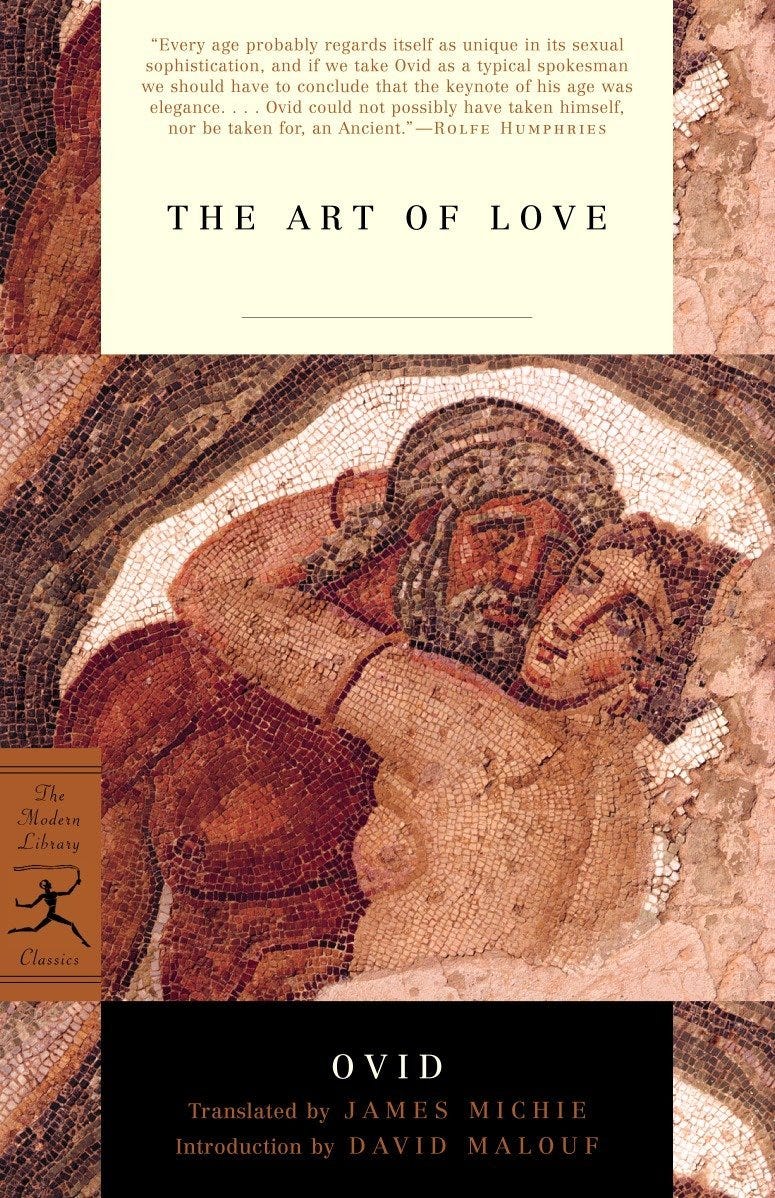Allusions, Literary: Ars Amatoria
This is obvious, but I would be remiss if I didn’t include it.
Perhaps they were no longer up to the vigorous, eager, reckless pleasures of youth, but those are rather conventional pleasures anyway, and Herb and Lorna were uniquely capable of something else, something richer, something skilled and clever, the considered, measured pleasures of a couple of master couplers, ready at last to reap the harvest of decades of imagination, plant the seeds for the mature masterpieces of a pair of love artists.
Herb ’n’ Lorna, Chapter 18
The Ars amatoria (English: The Art of Love) is an instructional elegy series in three books by the ancient Roman poet Ovid. It was written in 2 AD. …
Book one of Ars amatoria was written to show a man how to find a woman. In book two, Ovid shows how to keep her. The third book, written two years after the first books were published, gives women advice on how to win and keep the love of a man (“I have just armed the Greeks against the Amazons; now, Penthesilea, it remains for me to arm thee against the Greeks. . .”). …
It is striking that through all his ironic discourse, Ovid never becomes ribald or obscene. Of course “embarrassing” matters can never be entirely excluded, for “praecipue nostrum est, quod pudet, inquit, opus” “what brings a blush ... is our especial business here.” Sexual matters in the narrower sense are only dealt with at the end of each book, so here again, form and content converge in a subtly ingenious way. Things, so to speak, always end up in bed. But here, too, Ovid retains his style and his discretion, avoiding any pornographic tinge. The end of the second book deals with the pleasures of simultaneous orgasm. … At the end of the third part, as in the Kama Sutra, the sexual positions are “declined,” and from them women are exhorted to choose the most suitable, taking the proportions of their own bodies into careful consideration. …
See also: Allusion; Quotation TG 140; Books, Real and Fictional TG 99; Books: Covers TG 156
Have you missed an episode or two or several?
You can begin reading at the beginning or you can catch up by visiting the archive or consulting the index to the Topical Guide.
You can listen to the episodes on the Personal History podcast. Begin at the beginning or scroll through the episodes to find what you’ve missed.
You can ensure that you never miss a future issue by getting a free subscription. (You can help support the work by choosing a paid subscription instead.)
At Apple Books you can download free eBooks of “My Mother Takes a Tumble,” “Do Clams Bite?,” “Life on the Bolotomy,” “The Static of the Spheres,” “The Fox and the Clam,” “The Girl with the White Fur Muff,” “Take the Long Way Home,” “Call Me Larry,” and “The Young Tars,” the nine novellas in Little Follies, and Little Follies itself, which will give you all the novellas in one handy package.
You’ll find overviews of the entire work in An Introduction to The Personal History, Adventures, Experiences & Observations of Peter Leroy (a pdf document) and at Encyclopedia.com.
The serialization of The Personal History, Adventures, Experiences & Observations of Peter Leroy is supported by its readers. I sometimes earn affiliate fees when you click through the affiliate links in a post. EK
The illustration in the banner that opens each episode is from an illustration by Stewart Rouse that first appeared on the cover of the August 1931 issue of Modern Mechanics and Inventions.
www.erickraft.com
www.babbingtonpress.com



